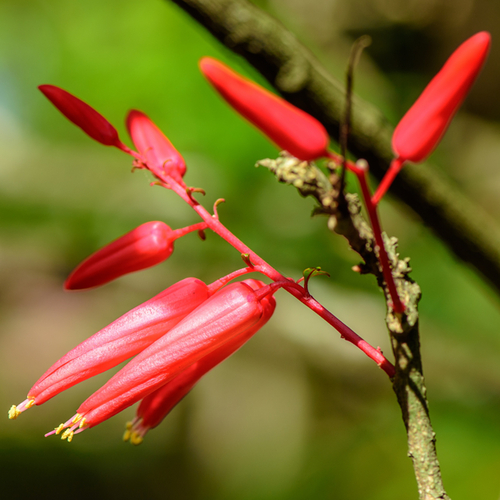
Background
People use quassia for stomach and intestinal problems, diabetes, lice, skin conditions, and many other conditions, but there is no good scientific evidence to support most uses.
In manufacturing, quassia is used to flavor foods, beverages, lozenges, and laxatives. The bark and wood have been used as an insecticide.
Safety Safety definitions
When applied to the skin: Quassia is POSSIBLY SAFE when applied to the skin.
When given as an enema (rectally): There isn't enough reliable information to know if quassia is safe or what the side effects might be.
Special Precautions & Warnings:
Pregnancy and breast-feeding: Quassia is LIKELY UNSAFE when taken by mouth during pregnancy or breast-feeding. It can cause cell damage and nausea. Avoid using.Diabetes: There is a concern that quassia might lower blood sugar levels. If you have diabetes and use quassia, be sure to monitor your blood sugar levels carefully. Check with your healthcare provider to see if the dose of diabetes medications you are taking needs to be lowered.
Digestive tract problems or diseases, such as stomach or intestinal ulcers, Crohn's disease, infections, and many other conditions: In large amounts quassia can irritate the digestive tract. Don't use it if you have one of these conditions.
Surgery: Quassia might lower blood sugar levels. There is some concern that it might interfere with blood sugar control during and after surgery. Stop using quassia at least 2 weeks before a scheduled surgery.
Effectiveness
- Lice. Early research suggests that a single application of quassia tincture can kill head lice. But the lice might come back. Some research shows that two applications within one week might be more effective than a single application.
- A skin condition that causes redness on the face (rosacea). Applying a gel containing quassia to the skin might reduce redness and flushing in people with rosacea. But higher quality research is needed to confirm.
- Rough, scaly skin on the scalp and face (seborrheic dermatitis). Applying a gel containing quassia to the skin might help clear up seborrheic dermatitis in some people. But higher quality research is needed to confirm.
- Diabetes.
- Appetite loss.
- Indigestion.
- Constipation.
- Fever.
- Intestinal worms.
- Other conditions.
Dosing & administration
Interactions with pharmaceuticals
Antacids
Interaction Rating=Minor Be watchful with this combination.
Antacids are used to decrease stomach acid. Quassia may increase stomach acid. By increasing stomach acid, quassia might decrease the effectiveness of antacids.
Some antacids include calcium carbonate (Tums, others), dihydroxyaluminum sodium carbonate (Rolaids, others), magaldrate (Riopan), magnesium sulfate (Bilagog), aluminum hydroxide (Amphojel), and others.
Digoxin (Lanoxin)
Interaction Rating=Moderate Be cautious with this combination.
Quassia is a type of laxative called a stimulant laxative. Stimulant laxatives can decrease potassium levels in the body. Low potassium levels can increase the risk of side effects of digoxin (Lanoxin).
Medications for diabetes (Antidiabetes drugs)
Interaction Rating=Moderate Be cautious with this combination.
Quassia might decrease blood sugar levels. Diabetes medications are also used to lower blood sugar. Taking quassia along with diabetes medications might cause your blood sugar to drop too low. Monitor your blood sugar closely. The dose of your diabetes medication might need to be changed.
Some medications used for diabetes include glimepiride (Amaryl), glyburide (DiaBeta, Glynase PresTab, Micronase), insulin, pioglitazone (Actos), rosiglitazone (Avandia), chlorpropamide (Diabinese), glipizide (Glucotrol), tolbutamide (Orinase), and others.
Medications that decrease stomach acid (H2-blockers)
Interaction Rating=Minor Be watchful with this combination.
Quassia might increase stomach acid. By increasing stomach acid, quassia might decrease the effectiveness of some medications that decrease stomach acid, called H2-blockers.
Some medications that decrease stomach acid include cimetidine (Tagamet), ranitidine (Zantac), nizatidine (Axid), and famotidine (Pepcid).
Medications that decrease stomach acid (Proton pump inhibitors)
Interaction Rating=Minor Be watchful with this combination.
Quassia might increase stomach acid. By increasing stomach acid, quassia might decrease the effectiveness of medications that are used to decrease stomach acid, called proton pump inhibitors.
Some medications that decrease stomach acid include omeprazole (Prilosec), lansoprazole (Prevacid), rabeprazole (Aciphex), pantoprazole (Protonix), and esomeprazole (Nexium).
Water pills (Diuretic drugs)
Interaction Rating=Moderate Be cautious with this combination.
Quassia is a laxative. Some laxatives can decrease potassium in the body. "Water pills" can also decrease potassium in the body. Taking quassia along with "water pills" might decrease potassium in the body too much.
Some "water pills" that can decrease potassium include chlorothiazide (Diuril), chlorthalidone (Thalitone), furosemide (Lasix), hydrochlorothiazide (HCTZ, HydroDiuril, Microzide), and others.
Interactions with herbs & supplements
Herbs that contain cardiac glycosides: Quassia contains chemicals called cardiac glycosides, which affect the heart. Using quassia with other herbs that also contain these chemicals might harm the heart. Avoid doing this. Herbs that contain cardiac glycosides include black hellebore, Canadian hemp roots, digitalis leaf, hedge mustard, figwort, lily of the valley roots, motherwort, oleander, pheasant's eye plant, pleurisy root, squill bulb leaf scales, strophanthus seeds, and uzara.
Horsetail: Quassia contains chemicals called cardiac glycosides. There is a concern that using horsetail with cardiac glycoside-containing herbs such as quassia increases the risk of heart damage due to loss of too much potassium.
Licorice: Quassia contains chemicals called cardiac glycosides. There is a concern that using licorice with cardiac glycoside-containing herbs such as quassia increases the risk of heart damage due to loss of too much potassium.
Stimulant laxative herbs: Quassia contains chemicals called cardiac glycosides. There is a concern that using herbs that act like stimulant laxatives along with cardiac glycoside-containing herbs such as quassia increases the risk of heart damage due to loss of too much potassium. Stimulant laxative herbs include aloe, alder buckthorn, black root, blue flag, butternut bark, colocynth, European buckthorn, fo-ti, gamboge, gossypol, greater bindweed, jalap, manna, Mexican scammony root, rhubarb, senna, and yellow dock.


